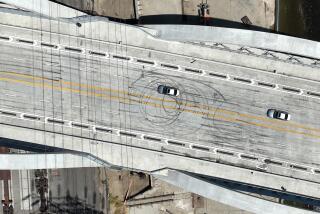Council OKs Plan to Build Highway Sound Wall : Thousand Oaks: City votes to allocate $890,000 for a barrier to help long-suffering residents along part of the Moorpark Freeway and seek reimbursement from state.
Giving the go-ahead to a project some residents have been waiting for since 1971, the Thousand Oaks City Council has approved a plan to use $890,000 in city funds for building a sound wall along the Moorpark Freeway.
But even as she joined other council members in the unanimous vote late Tuesday, Councilwoman Judy Lazar warned that sound walls have not always solved the noise problem in other communities.
Caltrans has long promised to build a sound wall to stop noise from bouncing off the freeway and into the Conejo Oaks neighborhood, but the budget-strapped agency is as many as 20 years away from being able to fund the $5-million project.
Responding to pleas from residents, the city decided to spend what money it has set aside in its sound-wall fund, then ask Caltrans for reimbursement. Although the $890,000 fund is not enough to solve all the noise problems along the freeway, city officials said it should be used as soon as possible to help the most affected areas.
“From a standpoint of funding, this is Phase 1,” Councilman Andy Fox said. “It is not the intention of the council to try to fix all the problems along Route 23 at once with the broad stroke of one brush.”
City staff members estimate it will take two years of planning and securing permits before the wall can be built.
Lazar agreed that the Conejo Oaks neighborhood, which has been pleading for a sound wall for nearly a quarter of a century, needs help. The freeway curves and tilts as it passes over nearby Paige Lane, creating a loud roar in the surrounding neighborhood.
Noise levels there are above the reasonable and healthful decibel level set by Caltrans, and traffic noise has grown worse ever since the Simi Valley Freeway was connected to the Moorpark Freeway in October, 1993.
But after Lazar was contacted by a resident who once lived in San Ramon--a Northern California community where residents complain that recently constructed sound walls have actually made noise problems worse--she developed concerns over how effective the sound wall will be in solving the problem.
She asked city staff members to look carefully at how a sound wall in Conejo Oaks might affect residents on the other side of the freeway.
“If we find that the direction in which we are going is not the right direction, we need to stop and reconsider,” Lazar said. “It’s not going to do us much good to put up a sound wall if in the end we have a problem like the one in San Ramon.”
In 1992 the California Department of Transportation spent $10 million to build sound walls in San Ramon, about 20 miles east of Oakland on Route 680. Although residents immediately adjacent to Route 680 say noise levels have dropped, others who live farther away say they now hear more traffic sounds than before.
San Ramon residents, city officials there confirm, have complained that sound walls on both sides of the freeway caused a reverberating effect that have heightened noise. In other areas, sound walls on only one side of the highway created more noise on the opposite side, neighbors said.
Caltrans engineer Chai Chongchaikit said the agency has spent $200,000 on extensive noise studies in San Ramon, including the hiring of an acoustical consultant. But he said there was no statistical proof to support the claims of residents.
“All of the studies concluded that there was no objective evidence that indicate any perceptible increased noise level,” Chongchaikit said.
Meanwhile, residents continue to complain, so much so that the San Ramon City Council will consider at its meeting April 11 spending $17,000 to conduct its own sound study.
“Caltrans claims they can find no difference,” said John Dillon, director of transportation services for San Ramon. “Yet lots of residents say they are wrong. They say ‘my ears don’t lie.’ ”
Caltrans engineer George Gherbrarious, who oversees sound-wall construction locally, said the agency has confidence in its studies showing a wall will ease traffic noise along the Moorpark Freeway.
“Reflected noise would be a very, very minor increase,” Gherbrarious said. “And there is no way any human being can notice it.”
More to Read
Sign up for Essential California
The most important California stories and recommendations in your inbox every morning.
You may occasionally receive promotional content from the Los Angeles Times.










